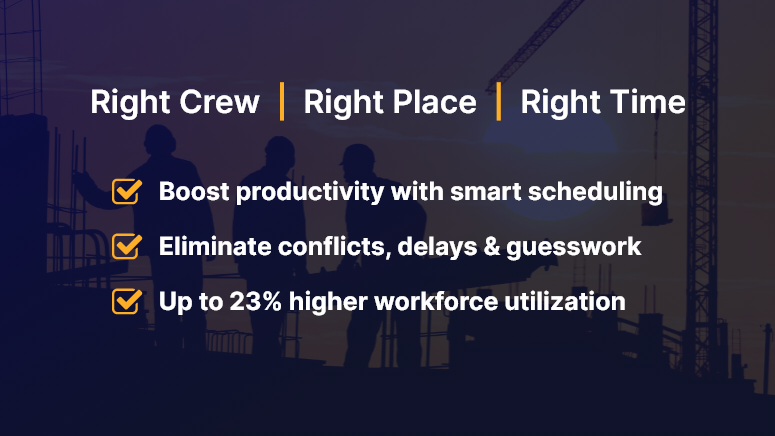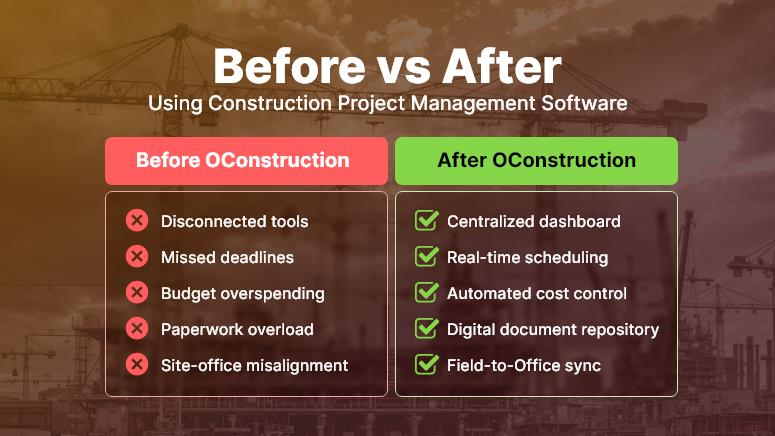In construction, the difference between on-time delivery and costly overruns often boils down to one key factor: effective workforce scheduling. According to McKinsey, large construction projects typically take 20% longer to finish than scheduled and are up to 80% over budget. One of the silent culprits? Poor scheduling of labor.
With project complexity rising, site coordination becoming more fragmented, and skilled labor harder to find, workforce scheduling in construction is no longer an administrative task — it’s a strategic driver. In this blog, we’ll explore why getting workforce scheduling right is critical, common pitfalls, and modern tools and tactics (including OConstruction) that empower you to schedule smarter, faster, and more effectively.

Business Relevance: Why Workforce Scheduling in Construction Matters
Workforce scheduling in construction isn’t just about putting names on a calendar. It directly impacts:
- Site productivity: Misaligned crews or delayed resources lead to idle time and wasted budgets.
- Project profitability: Labor is one of the highest costs in construction. Better scheduling leads to higher utilization and less overtime.
- Client satisfaction: Timely project delivery builds trust and boosts your company’s reputation.
Who Benefits the Most?
- Project Managers: Gain clear visibility into crew allocation and avoid last-minute reshuffling.
- Field Supervisors: Know who’s coming when and where — with real-time updates.
- Contractors/Subcontractors: Improve labor efficiency and avoid resource clashes across projects.
Real-World Use Cases
- Multi-site operations: Coordinating labor across 3+ sites with different timelines, climates, and contractor availability.
- Weather delays: Reacting in real-time to reschedule crews due to unforeseen weather conditions.
- Last-minute changes: Managing no-shows or urgent reassignments without breaking the entire workflow.
Without a streamlined digital approach, these scenarios result in delays, finger-pointing, and increased costs.
Tools, Tactics & Best Practices for Smarter Scheduling
1. Ditch the Spreadsheets
Stop using outdated Excel files and whiteboards. These lead to version control issues, manual errors, and communication gaps.
Do: Use a digital scheduling platform like OConstruction that offers real-time syncing and mobile access.
Don’t: Assume that one master sheet can handle multi-site, multi-crew complexity.
2. Use Role-Based Scheduling
Not all workers have the same skill sets. Role-based scheduling helps assign the right people to the right job.
Do: Categorize by certifications, skills, and availability.
Don’t: Assign workers based on seniority alone without assessing fit.
3. Integrate Resource Availability and Leave Management
Real-time availability prevents double booking and helps accommodate time-off requests without disrupting the timeline.
Do: Sync leave calendars with your scheduling tool.
Don’t: Assume manual updates will catch every conflict.
4. Visual Timelines & Gantt Charts
Construction timelines need visual clarity. Color-coded schedules help teams understand workload, gaps, and overlaps instantly.
Do: Create drag-and-drop crew plans using OConstruction’s Gantt chart.
Don’t: Expect field teams to interpret complicated, text-heavy schedules.
5. Enable Mobile Access
Workforce scheduling in construction is not just for the office. Your field teams need access on the go.
Do: Equip crew leads with mobile apps to view and confirm their daily tasks.
Don’t: Rely on office-to-site phone calls or printed schedules.
6. Real-Time Alerts and Notifications
Let tech do the reminding.
Do: Use auto-alerts for shift changes, location changes, and urgent reassignments.
Don’t: Depend solely on human follow-ups for critical updates.
7. Track Performance and Adjust
Use analytics to understand how your team is performing and what needs to change.
Do: Monitor metrics like workforce utilization, attendance, and task completion rates.
Don’t: Wait until the project closes to review what went wrong.
Customer Use Case
For example, SkyBuild Inc., a mid-sized commercial contractor, used OConstruction’s smart workforce scheduling module to streamline its crew allocation across six active sites. The result? A 23% boost in workforce utilization and a 15% reduction in project delays within just 60 days.
Here’s how: They switched from static spreadsheets to OConstruction’s dynamic scheduling dashboard, integrated labor availability with leave tracking, and empowered site leads with mobile apps for daily scheduling.
Key Takeaways & Summary
Workforce scheduling in construction is the engine behind timely project delivery and team productivity. From reducing idle labor to optimizing crew assignments, smart scheduling pays off across the board.
The best part? With modern platforms like OConstruction, construction leaders can move away from reactive scheduling and adopt a proactive, data-driven approach that scales.
Don’t let outdated methods slow your projects down. Modernize your workforce planning and start seeing the results on-site and on paper.



